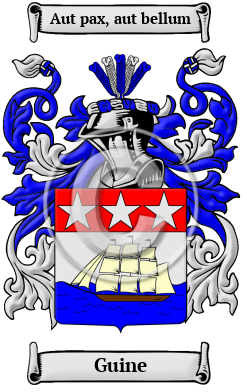| ![Show Contents]() Guine History, Family Crest & Coats of Arms Guine History, Family Crest & Coats of Arms
Etymology of GuineWhat does the name Guine mean? Guine is an ancient Viking-Scottish name derived from Gunni, a descendant of Einar and of the great peace Kings of Uppsale in Sweden, progenitor of this great Clan. Gunni was the son of Gillanders, one of the six northern Earls who besieged King Malcolm IV of Scotland at Perth in 1160. The Gunns, the Sinclairs, the Mackays and the Gordons ruled the far northern reaches of Scotland. The Gunns' territory centered in Caithness and Sutherland. Early Origins of the Guine familyThe surname Guine was first found in the Orkneys. But perhaps to North Americans the most interesting aspect of Gunn history is the discovery of a Coat of Arms, which is undoubtedly of the Gunn Clan, in Westford, Massachusetts. Chiseled into a rock face, it has been reliably dated back to 1395. This was almost one hundred years before Columbus discovered America. Archaeologists first assumed this marking was the work of an early Indian tribe, but closer examination and the clearance of the scrub, revealed a knight in full armor, a huge sword and a shield on which the Gunn Coat of Arms was displayed. How did a Knight of the Gunn Clan manage to be buried in Massachusetts years before Columbus discovered America? For the answer, historians went back to the Orkneys. They knew that the Jarls of Orkney, many centuries before had recorded that they wintered in their Viking missions in a land running with fire from the rocks (Nova Scotia, also on the east coast of North America, has bituminous rocks, which can catch fire and melt down the ravines to the sea). They also knew that the Gunns were related to and rode and sailed with the Jarls of Orkney. The pieces of the puzzle fit together fine, but few historians had realized to that point that the Viking discoveries of the New World had penetrated as far south as Massachusetts. This carving is one of the few real evidences of their pioneering expeditions. It is also the earliest record of a Gunn Clan Coat of Arms. Early History of the Guine familyThis web page shows only a small excerpt of our Guine research. Another 152 words (11 lines of text) covering the years 1231, 1438, 1732, 1740, 1753 and 1890 are included under the topic Early Guine History in all our PDF Extended History products and printed products wherever possible. Guine Spelling VariationsScottish names from the Middle Ages vary enormously in their spellings. This is a result of the fact that there were no universal standards like dictionaries for scribes to judge by. The recorded spelling variations of the name Guine include Gunn, Gun, Guinne (Gaelic) and others. Early Notables of the Guine familyAnother 50 words (4 lines of text) are included under the topic Early Guine Notables in all our PDF Extended History products and printed products wherever possible. Guine RankingIn France, the name Guine is the 6,631st most popular surname with an estimated 1,000 - 1,500 people with that name. 1 Migration of the Guine family to IrelandSome of the Guine family moved to Ireland, but this topic is not covered in this excerpt.
Another 66 words (5 lines of text) about their life in Ireland is included in all our PDF Extended History products and printed products wherever possible.
| Guine migration to the United States | + |
Settlers found farms all along the eastern part of what would become the United States and Canada. They provided a base and a backbone that would strengthen two great nations in the making. In the 20th century, the ancestors of those brave Scots have rediscovered their heritage through highland games and Scottish historical societies. Early North American immigration records have revealed a number of people bearing the Scottish name Guine or a variant listed above, including:
Guine Settlers in United States in the 17th Century- Thomas Guine, who arrived in Virginia in 1622 2
- Griffine Guiné who settled in Virginia in 1623
- Thomas Guiné, who settled in Virginia in 1623
The motto was originally a war cry or slogan. Mottoes first began to be shown with arms in the 14th and 15th centuries, but were not in general use until the 17th century. Thus the oldest coats of arms generally do not include a motto. Mottoes seldom form part of the grant of arms: Under most heraldic authorities, a motto is an optional component of the coat of arms, and can be added to or changed at will; many families have chosen not to display a motto.
Motto: Aut pax, aut bellum
Motto Translation: Either peace or war
- http://www.journaldesfemmes.com/nom-de-famille/nom/
- Filby, P. William, Meyer, Mary K., Passenger and immigration lists index : a guide to published arrival records of about 500,000 passengers who came to the United States and Canada in the seventeenth, eighteenth, and nineteenth centuries. 1982-1985 Cumulated Supplements in Four Volumes Detroit, Mich. : Gale Research Co., 1985, Print (ISBN 0-8103-1795-8)
 |

